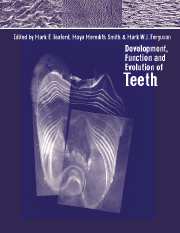Book contents
- Frontmatter
- Contents
- List of contributors
- Acknowledgements
- Part one Genes, molecules and tooth initiation
- Part two Tooth tissues: development and evolution
- 5 Evolutionary origins of dentine in the fossil record of early vertebrates: diversity, development and function
- 6 Pulpo-dentinal interactions in development and repair of dentine
- 7 Prismless enamel in amniotes: terminology, function, and evolution
- 8 Two different strategies in enamel differentiation: Marsupialia versus Eutheria
- 9 Incremental markings in enamel and dentine: what they can tell us about the way teeth grow
- Part three Evolution of tooth shape and dentition
- Part four Macrostructure and function
- Index
5 - Evolutionary origins of dentine in the fossil record of early vertebrates: diversity, development and function
Published online by Cambridge University Press: 11 September 2009
- Frontmatter
- Contents
- List of contributors
- Acknowledgements
- Part one Genes, molecules and tooth initiation
- Part two Tooth tissues: development and evolution
- 5 Evolutionary origins of dentine in the fossil record of early vertebrates: diversity, development and function
- 6 Pulpo-dentinal interactions in development and repair of dentine
- 7 Prismless enamel in amniotes: terminology, function, and evolution
- 8 Two different strategies in enamel differentiation: Marsupialia versus Eutheria
- 9 Incremental markings in enamel and dentine: what they can tell us about the way teeth grow
- Part three Evolution of tooth shape and dentition
- Part four Macrostructure and function
- Index
Summary
5.1 Introduction
Dentine has a central role in the support and function of the tooth. It is formed at the interface of the dental epithelium and dental mesenchyme (see Chapter 4), and is the vital link or selective barrier between the sensory and vascular supply of the pulp and the functional surface of the tooth, usually enamel of the crown (see Chapter 6). How do the formative cells mediate between the environment of the tooth surface and the tissue they maintain, either to allow a sensory function, or to effect repair of the dentine to maintain a supportive but wear-resistant material but still with vital properties? Curiously these are questions that still remain largely unsolved.
As Lumsden (1987) emphasised, the initial appearance of dentine in the exoskeleton, largely as a protective cover to the skin, probably allowed the Ordovician agnathans to detect tactile, temperature and osmotic changes. This view that dentine allowed the earliest vertebrates to engage in electroreception, was advanced by Northcutt and Gans (1983), Gans and Northcutt (1983) and Gans (1987) (see section 5.5.1). Neural crest-derived cells, initially with a sensory function, became one population of skeletogenic cells, possibly providing a sensory function for dentine as one of the first vertebrate hard tissues. Although Tarlo (1965) drew attention to the striking similarity between human orthodentine and the dentine of the dermal armour of an early jawless (agnathan) heterostracan fish, little insight has been gained into how this histological similarity might allow a comparable sensory mechanism. In the heterostracan example the dentine tubercles are not covered by enamel.
Information
- Type
- Chapter
- Information
- Development, Function and Evolution of Teeth , pp. 65 - 81Publisher: Cambridge University PressPrint publication year: 2000
Accessibility standard: Unknown
Why this information is here
This section outlines the accessibility features of this content - including support for screen readers, full keyboard navigation and high-contrast display options. This may not be relevant for you.Accessibility Information
- 35
- Cited by
